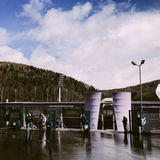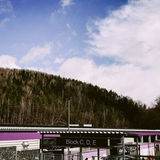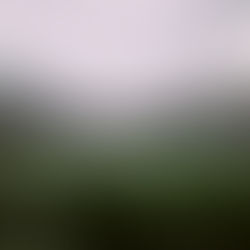
FC ERZGEBIRGE AUE
OCTOBER 2025
.png)
Founded: Mar 4, 1946
Club Members: 9,500
Nickname: Die Veilchen
Coach: Jens Härtel
Captain: Martin Männel
DDR Oberliga Champions: 3
FDGB-Pokal: 1
Regionalliga Nord: 1
Landespokal Sachsen Winner: 4
Website: www.fc-erzgebirge.de
Known as the 'Schalke of the East' on account of their shared mining heritage, FC Erzgebirge Aue's history is like that of many former East German clubs - a constant flux of mergers, dissolutions and name changes. Their origins can be traced back to the formation of a long-forgotten club called FC Aue in 1908 and after a couple of early name changes, which saw them become FC Jung Deutschland in 1910 and then FC Alemannia Aue in 1912, the club won their first silverware when they lifted the inaugural Gauliga Erzgebirge title in 1913. Another name change - this time to SV Alemannia Aue - followed in 1921 and the club settled down as a largely uncompetitive side in the second-tier Gau Sachsen until pressure from the National Socialists forced a merger with VfB Aue and the creation of a new club called SV Aue in 1937.
Allied tanks on the streets of Berlin brought Hitler's 'Thousand Year Reich' to an end in 1945 and a policy of de-Nazification in occupied Germany saw all sports clubs forced to disband. With no team to support, fans were on the look-out for an 'ideologically safe' representative - one that didn't have any links to fascism - and amidst simmering tension between the western allies and the Soviets, a new club called SG Aue (SG stands for 'Sports Community') rose from the ashes in 1946. A series of name changes over the next few years saw them called 'BSG Pneumatik Aue' (1949) and 'BSG Zentra Wismut Aue' (1950) before settling on 'BSG Wismut Aue' in 1951. That same year, Wismut (named after the local mining company that was the club's primary state-backed sponsor) became one of the founding members of the top-flight DDR-Oberliga and finished as national runners-up in 1953 after a narrow 3-2 defeat against eventual champions SG Dynamo Dresden in the play-off final.
Football may not have been a religion in East Germany, but it did carry a hefty ideological burden. Erich Mielke, the infamous head of the Stasi, once said "Football success will highlight even more clearly the superiority of our socialist order in the area of sport" and it was the practice of 'Leistungssteigerung durch Konzentration' (increased performance through concentration) that saw Wismut's near neighbours BSG Empor Lauter ordered to relocate to the Baltic port city of Rostock in 1954. Empor's eviction from Saxony, which had become something of a football hotbed in the East, left a void for Wismut to try and establish themselves as 'the team of the Erzgerbirge'. The apparatchiks however had other plans in mind for them and having decided that the city of Karl Marx Stadt (now 'Chemnitz', if you're looking for it on a map) could also do with a decent team, told Wismut to pack up and form a new club in the regional capital. Whilst fans in Lauter had been powerless to prevent their relocation, the town of Aue is no stranger to resistance and three years after its miners staged East Germany's first strike in 1951, they threatened to down tools again in protest at the potential loss of their football club. The stand made by the Wismut Kumpels (workmates) forced the state authorities into a compromise that would see the Wismut team continue to play at their Otto Grotewohl Stadion in Aue but only with a new identity - that of SC Wismut Karl Marx Stadt.
It was under this new name that the club became a dominant force for the rest of the decade - winning three DDR-Oberliga titles, an FDGB-Pokal and becoming the first East German side to play in the European Cup when they were given a first-round draw against Dutch champions Ajax in 1957. The tie against the inventors of total football however also highlighted the straitened economic realities of being a modest club from a small mountain town on the other side of the Iron Curtain. Having lost the home leg 3-1, Wismut were making their way to the Netherlands for the return match but with GDR authorities holding the purse strings for sports-related travel very tightly, a missed connection saw the travellers stranded in West Germany without any money. Wismut coach Fritz Gödicke ended up pawning his watch and managed to scrape together enough Deutschmarks to buy his squad a frugal meal and three-in-a-bed accommodation that night. Perhaps unsurprisingly, the team lost 1-0 in Amsterdam the following day and crashed out of the competition but, after learning about their visitors' less than ideal preparation, Ajax officials generously picked up the Wismut hotel tab and took Gödicke's watch 'out of hock' for him.
After coming close to adding another FDGB-Pokal to the trophy cabinet in 1959 (they lost 3-2 after a replay against SC Dynamo Berlin), the club reclaimed their post-war identity of BSG Wismut Aue in 1963 and became an almost permanent fixture in the Oberliga - spending every season in the top-flight right up until the end of the 1980s despite the rise of hooliganism and widespread corruption destabilising the once-great league.
By then however, the winds of change were blowing across Europe as socio-political events superseded sport and as the Berlin Wall fell and a demographic exodus headed west, football across the unified Germany was re-organised. Now known as FC Wismut Aue, the club began the post-Wende era in the fourth-tier NOFV Oberliga Süd but like many former East German clubs post-reunification, the ever-increasing gap between profit and loss as a result of dwindling attendances and an inability to compete with the riches of clubs in 'the west' brought Wismut to the brink of bankruptcy by 1992. A financial restructuring plan headed up by future club presidents Uwe and Helge Leonhardt walked the club back from the cliff edge before attention turned to the battle for hearts and minds in order to keep the turnstiles turning and prevent a repeat of previous financial struggles. As the biggest employer in the region, many in the Erzgebirge identified with the name 'Wismut' - even though the company mined uranium for the Soviet Union's nuclear missile programme. The Leonhardt brothers however saw the opportunity for a reboot and promote the whole region through its football club without any association to Cold War tensions. In 1992 therefore Uwe Leonhardt made the announcement that "There is FC Bayern München ... and there is now FC Erzgebirge Aue! "
Rebranding the club and securing its financial future seemed to liberate Erzgebirge on the pitch and as the storm clouds lifted, they began a resurgence that saw them rise to the third-tier Regionalliga Nord, before holding off the challenge of VfL Osnabrück in 2003 to win the league and promotion to Bundesliga.2. With a population of just 17,000, Aue became one of the smallest towns to have ever hosted Bundesliga.2 football but managed to hold their own in the German second tier for the best part of the next 20 years - often being the highest-ranked of all the GDR clubs that began the 'Turning Season' in 1989. Aue are back in the 3.Liga now but, for the fans at least, it's never been about chasing glory on the pitch - it's about their club being the beating heart of a proud mining region that football helped put on the map.


GROUND DETAILS
Ground Name: Erzgebirgsstadion
Architect: Beyer Architekten (2015)
Built: 1950
Year Opened: 1950
Renovations: 1958, 1986 - 1992, 2004, 2010, 2015 - 2018
Capacity: 15,500 (6,640 standing)
VIP Seats: 990
Wheelchair Spaces: 60
Construction Costs: €19.86m
Undersoil Heating: Yes
Running Track: No
Playing Surface: Natural Grass
Pitch Size: 105m x 70m
Grounds:
Städtisches Stadion (1946 - 1950)
Otto Grotewohl Stadion (1950 - 1991)
Erzgebirgsstadion (1991 - 2011) *
Sparkassen Erzgebirgsstadion (2011 - 2017) *
Erzgebirgsstadion (2017 - ) *
* Stadium Renamed



Built in just four months to replace the Städisches Stadion which had quickly become too small to cope with the demands being put upon it by Aue's myriad predecessor clubs, the Otto Grotewohl Stadion was named after the first GDR prime minister and opened on 20th August 1950 with a 3-3 draw between BSG Zentra Wismut Aue and Waggonbau Dessau. With a capacity of 22,000, it was part of a multi-sports complex and in addition to hosting numerous athletics and swimming events, was also home to the dominant force in East German football at the time - SC Wismut Karl Mark Stadt. To keep pace with Wismut's on-field success, work was carried out in 1958 that saw the total capacity brought close to 25,000.
Like many clubs in the former East Germany however, Wismut struggled financially as the bleak austerity of communism meant that there was no money for ground development and it wasn't until 1986 therefore that an overhaul was carried out to address the spartan facilities on offer at "Der Schacht " (The Shaft ).
Over the next six years, the ground underwent an extensive revamp and on 13th October 1989, the 'Fluchtlicht-Premiere' saw floodlights used for the first time when 26,000 fans gathered to watch BSG Wismut Aue take on DDR-Oberliga high-flyers 1.FC Magdeburg in the 1000th match of their history. By this time however, the winds of change were blowing across Europe as socio-political events superseded sport and after the Berlin Wall fell a few weeks later, the state-owned SDAG Wismut uranium mining company handed over ownership of the stadium to the district council of Aue who renamed it 'Erzgebirgsstadion' on 13th November 1991.
As East Germany's top clubs struggled to adapt to the free-market Bundesliga however, further development of the stadium wasn't carried out until 2004 when undersoil heating was installed and the synthetic athletics track around the pitch dyed violet. At the same time, the club acquired a new video screen when fellow 'miners' and Bundesliga heavyweights FC Schalke 04 were clearing out their old Parkstadion before moving into the Veltins Arena. Further upgrades then saw the dilapidated Gegengerade terracing converted into a covered all-seater stand during the summer of 2010 before the stadium was renamed 'Sparkassen Erzgebirgsstadion' a year later when naming rights were sold to a consortium of local banks for €500,000 a season.
By 2017, the municipal-owned stadium was known as the 'Erzgebirgsstadion' again but by then plans to completely demolish the ground and build a modern football-only venue on the site were well underway.
Costing €19.86 million and with a capacity of 15,500, the 'new' Erzgebirgsstadion officially opened on 29th July 2018 with a friendly against FC Schalke 04 (Aue won 1-0) although it's fair to say that, apart from its setting in the Ore mountains and the violet club colours boldly represented around the stadium, it's nothing out of the ordinary - just another of the pre-fab, single-tiered, box-shaped variety with a bank of obligatory VIP boxes dominating the Nordtribüne (main stand). The fully terraced Westtribüne (Blocks AB-OP) behind the goal is where Aue's most vocal support belt out noisy renditions of 'Aue, Wismut !', 'Schalala Aue ' and the old miner's song 'Glück Auf, Der Steiger kommt '; with away followings singing their terrace favourites from the south-east corner of the ground (Block G1).
However, unlike most new-build grounds which have phased out traditional floodlight pylons in favour of budget-saving illumination along the roof, the iconic Soviet-era masts have been kept as a legacy of the "Old Otto" and they bend inquisitively over its latest incarnation - elevating any evening kick-off at the Erzgebirgsstadion from dull to dramatic.
BUYING TICKETS
Ticket Office:
Website: www.fc-erzgebirge.de
Telephone: +49 (0) 3771 598233030
Email: ticket@fc-erzgebirge.de

Average Attendance:
2024-2025: 8,972 (3.Liga)
2023-2024: 8,772 (3.Liga)
2022-2023: 7,764 (Bundesliga.2)
2021-2022: 5,650 (Bundesliga.2) *
2020-2021: N/A *
* Season affected by COVID pandemic
Expected Ticket Availability
After this small-town club's big achievement in becoming a long-term fixture in Bundesliga.2, relegation to the 3.Liga means there's no need for a mad scramble and plenty of tickets will be available on all but one or two matchdays.
The club website and online ticket shop are both "auf Deutsch " but Google’s translation feature does a fine job of making the ticket buying process nice and straightforward for non-German speakers. In addition to E-Ticket options (Mobile Ticket / Print@Home), you can also pick up a real ticket for your collection by visiting the fan shop or box office at the stadium; or by heading to a number of Vorverkaufsstellen (advance sales outlets) in the region and the club provide a list of them here.
The cost of an afternoon at 'Der Schacht ' (The Shaft ) will depend on where you want to watch the action from. Seats will cost adults €21-32, seniors and concessions €18-27; and children (aged 6-14) will be let in for €14. To stand on the Westtribüne terrace behind the goal, it's €16 for adults, €12 for seniors and concessions; and under-14s will cost their parents €9. Fans under-5 are let into the ground free of charge although they aren't entitled to a seat and must sit on their parent's lap.
Family tickets (Blocks I1 and I2) are also available for a not unreasonable €26 (1 adult, 1 child under-14), €40 (2 adults, 1 child under-14) and €51 (2 adults, 2 children under-14). Aue will take an extra couple of euros off you if you prefer to keep things traditional by buying your ticket on a matchday at the stadium.
Information about visiting the Erzgebirgsstadion for fans with disabilities can be found at:
www.bundesliga-reisefuehrer.de
GETTING THERE & AWAY
Stadium Address:
Lößnitzer Straße 95
08280 Aue-Bad Schlema


BY CAR:
If you've decided to drive, the simplest advice is to put the stadium address (see left) in your Sat-Nav and follow its guidance. When it comes to parking though, Aue recommend parking up in the city centre including 'Anton-Günther-Platz' (Lessingstraße, 08280 Aue-Bad Schlema) from where free shuttle buses run to the stadium and back after the end of the game.
Nearer the ground, free parking is available at the Volksbank car park, a five minute walk away at the junction of Lößnitzer Straße and Chemnitzer Straße. In the immediate vicinity of the Erzgebirgsstadion, car parks P10 and P11 are also available. However, P10 is reserved for permit holders only (€4 per vehicle) and it costs €3 per vehicle (cash only) to use P11.
PUBLIC TRANSPORT:
It's fair to say that sleepy Aue is a bit of a footballing outpost and certainly not the base camp of choice when it comes to watching 'Eastern' football in Germany. There's only one hotel (Hotel Blauer Engel) in the town itself and unless you're on the RB 95 train that shuttles between Zwickau and Johanngeorgenstadt, getting there by public transport is going to involve taking a bus at some point.
From Chemnitz, your best option is to hop on the 383 bus (Direction: Aue, Postplatz) which leaves the bus station (Bus stand 106) outside the Hauptbahnhof at 12 minutes past the hour and stops 45 minutes later directly outside the stadium. The Erzgebirgsstadion itself sits on the slopes of the Ore mountains above the town centre and to get there from the main station, non-mountaineers have a choice of taking either Tram C13 (Direction: Burgstädt) or buses 363, 378 and 383 to 'Aue, Stadion'.
Unfortunately, match tickets DO NOT include the cost of getting you to and from the ground on a matchday.
WALKING DIRECTIONS:
Walking to the Erzgebirgsstadion involves a significant climb up a hill from the town centre a mile or so away. If you're feeling energetic, then exit Aue (Sachs) rail station, turn left onto Bahnhofstraße and follow it under the Bahnhofsbrücke road bridge until you come to the junction with Erdmann-Kircheis-Straße. Turn left here, and after 50 metres, go left again onto Pfarrstraße which takes you through a subway tunnel under the railway. Go straight onto Am Bahnhof which will bear to the left and lead you onto Lößnitzer Straße (B169). Follow Lößnitzer Straße for about a mile until you reach the junction with Chemnitzer Straße (look for the well-known fast food restaurant on the corner). Go straight over the junction onto Auer Straße and the stadium will be right ahead of you.
FAN SHOP, MUSEUM & STADIUM TOURS

FAN SHOP:
There's a well stocked fan shop behind the Nordtribüne selling all sorts of Veilchen souvenirs and match tickets (10am-6pm, Tue-Fri; 10am-12pm, Sat; two hours before kick-off and for one hour after full-time on matchdays; tel: +49 (0) 3771 598234027; email: shop@fc-erzgebirge.de).
STADIUM TOURS:
Two hour guided tours including the players' tunnel, mixed zone and VIP areas while enjoying traditional bacon bread and schnapps are conducted around the Erzgebirgsstadion on non-match days. More details, prices and booking information can be found here.
FOOD & DRINK OPTIONS
The usual kiosks set up to feed and water the crowds on matchday and as compensation for the hassle of actually getting to Aue, the club haven't introduced a stadium card system and will let you pay for everything with cash.
OTHER CLUBS IN THE AREA
BUNDESLIGA: 1.FC Union Berlin, FC St. Pauli, Hamburger SV, RB Leipzig, VfL Wolfsburg
BUNDESLIGA 2: 1.FC Magdeburg, Eintracht Braunschweig, Hannover 96, Hertha BSC, SG Dynamo Dresden
3.LIGA: Energie Cottbus, FC Hansa Rostock















































